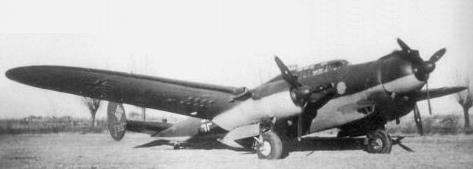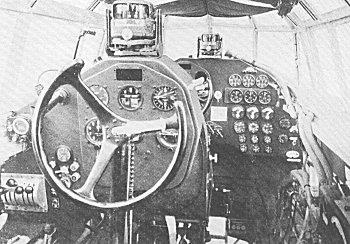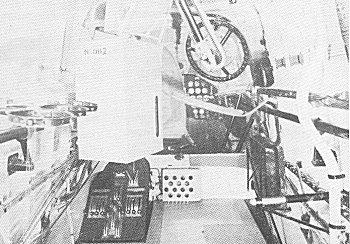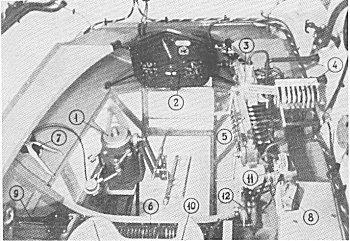The CANT Z.1007 Alcione (Kingfisher) was an Italian three-engined medium bomber, with wooden structure. Designed by Filippo Zappata, who also designed the CANT Z.506 it had "excellent flying characteristics and good stability" and was regarded by some as "the best Italian bomber of World War II" although its wooden structure was easily damaged by the climate, as experienced in North Africa and in Russia. It was used by the Italian Regia Aeronautica, Italian Co-Belligerent Air Force, Aeronautica Nazionale Repubblicana and Luftwaffe during World War II.
In 1935, Filippo Zappata, the chief designer of the Cantieri Aeronautici e Navali Triestini (CANT), designed two medium bombers, the twin-engined CANT Z.1011 and the three-engined CANT Z.1007. Both were to be powered by 619 kW (830 hp) Isotta-Fraschini Asso XI.RC inline engines and were of wooden construction. The Z.1007 design was preferred by both Zappata and the Italian Aviation Ministry, with an order for 18 aircraft being placed on 9 January 1936. A further order for 16 more aircraft followed on 23 February 1937.
The Cant Z.1007 was developed from the CANT Z.506 seaplane, an aircraft that had established many world records in the late 1930s. It was a land-based version and incorporated many improvements, especially on the powerplant.
The first prototype flew in March 1937, proving superior to the Z.1011, with its handling and manoeuvrability being praised. Its performance, however, was lower than predicted, and Zappata therefore started a major redesign of the Z.1007, production of the initial version being limited to the existing orders placed before the prototype flew
The Z.1007 was a mid-winged monoplane with a retractable tailwheel undercarriage. It had a crew of five, consisting of two pilots, a flight engineer, a radio operator and a bombardier/navigator. It could carry 800 kg of bombs, and was fitted with a defensive armament of a 12.7 mm Breda-SAFAT machine gun in an open dorsal position and a 7.7 mm machine gun in a ventral tunnel. After much experimentation with the prototype, the production aircraft were fitted with annular radiators so their profile was similar to radial engines that would be fitted to the improved later versions. Delivery of production Asso powered Z.1007s started in February 1939, with production ending in October that year
Zappata had, meanwhile, continued the development of a considerably changed version, the Z.1007bis, to resolve the problems with the original aircraft. While the new version was of similar layout, it was a new design. Three Piaggio P.XI RC.40 radial engines (a derivative of the French Gnome-Rhône 14K) of 736 kW (986 hp) takeoff power replaced the less powerful and unreliable liquid cooled engines of the original version. The bis was longer with wings of greater span and area, while the aircraft was considerably heavier, weighing 580 kg more unladen, with a maximum takeoff weight 888 kg greater. It carried heavier offensive and defensive armament.
The prototype bis first flew in July 1939, with testing proving successful. The Z.1007bis was ordered into large scale production, deliveries of pre-production aircraft starting late that year.
The Z.1007 had a standard monoplane configuration, with a mid-set wing, single tail, retractable undercarriage and a crew of five or six. It had a wooden structure and a clean shape that was much more aerodynamic than the competing SM.79. The Z.1007 had three engines, with one engine in the nose and two in the wings. The trimotor design was a common feature of Italian aircraft of World War II. The aircraft had a slim fuselage as the two pilots sat in tandem rather than side-by-side as in most bombers of the period. Visibility was good and the aircraft was almost a three-engine fighter. This slimness reduced drag but also somewhat worsened the task of the two pilots. Both pilots' seats were offset to port to allow a passageway for the bombardier to enter his compartment below the pilot's feet (directly behind the central engine), by ducking through an opening under the starboard instrument panel. Both front and rear instrument panels contained flight and navigation instruments, while the engine monitoring gauges were located to starboard where the rear pilot could see them past the front pilot's shoulder. Although the rear pilot's view was limited, he was capable of landing or taking off if needed. However, his primary purpose was to allow the pilot to rest, and to add some "muscle" to the controls when needed, as well as acting as an extra set of eyes to notice problems and to monitor gauges while the other was occupied. There were five crew members: the pilot, the copilot, a bombardier/navigator/ventral gunner, a dorsal gunner/radio operator, and waist gunner/flight engineer. The radio equipment was located in the center section between the dorsal turret and the waist position. Like most tri-motor Italian aircraft of the period the Z.1007 suffered from poor defensive armament, although it was no worse than many other contemporary designs, many of which had no rotating dorsal turret, no waist guns, or no ventral gun, or various combinations of such. Other issues were poor engine reliability and a weak power-to-weight ratio due to low powered engines (the three 1,000 hp engines of the Z.1007bis were equivalent to twin engines of 1,500 hp each, but this was slightly offset by the added weight of the third engine). The Z.1007 also suffered longitudinal stability problems that were partly rectified later by the adoption of a twin tail arrangement. The Z.1007's wooden structure suffered cracks, separations and surface delamination due to the difficult climatic conditions in North Africa and Russia, but allowed the plane to float in case of ditching. The surface delamination and deformation greatly added to the aircraft’s drag. A total of 660 Alciones were built.
The Z.1007 had a defensive armament of four machine guns: two 12.7 mm and two 7.7 mm . The main defensive weapon was a Caproni-Lanciani Delta manually powered Isotta Fraschini dorsal turret armed with a 12.7 mm Scotti or Breda-SAFAT machine gun. The turret had a good field of fire, although it had blind spot behind the tail (as did all turreted aircraft without rear gunners or twin vertical stabilizers). The 12.7 mm Breda was a standard weapon for Italian bombers and the field of fire was improved by the twin-tail configuration on later models. An electrically powered Breda V turret carrying a similar armament was substituted in late production aircraft. Another 12.7 mm was in the ventral position behind the bomb bay, with a field of fire restricted to the lower rear quadrant of the aircraft. There were also two waist position 7.7 mm Breda machine guns, with 500 rpg. Only one of the waist guns could be used at a time since the gunner for this position manned both guns Simultaneous attacks from both sides were generally rare, and waist guns are generally the least effective armament on an aircraft, mostly intended to improve morale and provide a deterrent effect. Allied reports stated that armour was better than usual for an Italian bomber, with the dorsal gunner receiving a large 0,76 m × 1.1 m armor plate, plus a small head protection plate of 0,36 m × 0,20 m , as well as an 8 mm thick curved plate which rotated with his turret. There was rear armor plate 5 mm thick for side gunners, with other 6 mm all around the machine guns, and 6 mm armor for ventral machine gun position, which meant that all defensive positions were reasonably protected against light enemy fire and fragments. The pilots were protected with 5 mm roof and lateral armor, 6 mm around the seats, 5 mm overhead, and a 6 mm armored bulkhead behind them.
The Z.1007 had a long, shallow horizontal bomb bay which could carry 1,200 kg of ordnance. Many other Italian aircraft had bomb bays which carried the ordnance vertically, tip pointing up, which limited the size and variety of bombs which could be carried internally, a problem shared with the German He 111 bomber. There were also a pair of under-wing hardpoints which could carry up to 1,000 kg of bombs, giving the Z.1007 a potential 2,200 kg payload and a maximum range of 640 km , but the standard payload was 1,200 kg and 1,000 km range. The Z.1007's external hardpoints were a rarity in the bombers of the Regia Aereonautica. The Z.1007 could also carry two 454 mm , 800 kg torpedoes slung externally under the belly in an anti-shipping role, an option never used operationally. The bombardier's position was just below and ahead of the pilot, behind the central engine (he could look up at the rudder pedals and see the pilot's face). This improved the layout compared to the SM.79, which located the bombardier in the ventral casemate under the rear fuselage, which meant that it was difficult to man the ventral gun while the bombardier was in position, since space was limited. The forward location of the bombardier's compartment gave him somewhat better forward visibility, but was still cramped, and very loud and full of vibration, being directly behind, and very close to the central engine.
| Type |
5 seat medium bomber |
| Engine |
3 Piaggio P.XI R.C.40 with 3-bladed variable pitch propellers |
| Dimensions |
Length 18,35 m , height 5,22 m , span 24,8 m , wing area 70 m2 , |
| Weights |
Empty 9396 kg, loaded , max. take off weight 13621 kg |
| Performance |
Max. speed 458 km/h , cruising speed 338 km/h , range 1795 km, endurance , service ceiling 7500 m , climb |
| Armament |
2 12,7 mm Isotta-Fraschini Scotti or Breda-SAFAT machine guns, 2 7.7 mm Breda-SAFAT machine guns. Bombs:1,200 kg of bombs internally. 1,000 kg externally on underwing hardpoints. Or a combined load of 2.200 kg of bombs internally and on external hard points.. 2 x 450 mm 800 kg , torpedoes |



